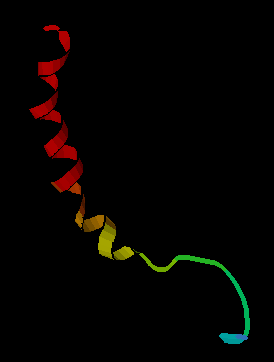
Neuropeptide Y (NPY) is a 36 amino-acid neuropeptide that is involved in various physiological and homeostatic processes in both the central and peripheral nervous systems. NPY has been identified as the most abundant peptide present in the mammalian central nervous system, which consists of the brain and spinal cord. It is secreted alongside other neurotransmitters such as GABA and glutamate.
Neuropeptide Y receptors are a family of receptors belonging to class A G-protein coupled receptors and they are activated by the closely related peptide hormones neuropeptide Y, peptide YY and pancreatic polypeptide. These receptors are involved in the control of a diverse set of behavioral processes including appetite, circadian rhythm, and anxiety.
Neurokinin 1 (NK1) antagonists (-pitants) are a novel class of medications that possesses unique antidepressant, anxiolytic, and antiemetic properties. NK-1 antagonists boost the efficacy of 5-HT3 antagonists to prevent nausea and vomiting. The discovery of neurokinin 1 (NK1) receptor antagonists was a turning point in the prevention of nausea and vomiting associated with cancer chemotherapy.

The 5-HT3 antagonists, informally known as "setrons", are a class of drugs that act as receptor antagonists at the 5-HT3 receptor, a subtype of serotonin receptor found in terminals of the vagus nerve and in certain areas of the brain. With the notable exceptions of alosetron and cilansetron, which are used in the treatment of irritable bowel syndrome, all 5-HT3 antagonists are antiemetics, used in the prevention and treatment of nausea and vomiting. They are particularly effective in controlling the nausea and vomiting produced by cancer chemotherapy and are considered the gold standard for this purpose.

Orexin receptor type 2 (Ox2R or OX2), also known as hypocretin receptor type 2 (HcrtR2), is a protein that in humans is encoded by the HCRTR2 gene.

Neuropeptide Y receptor type 1 is a protein that in humans is encoded by the NPY1R gene.

Neuropeptide Y receptor type 2 (Y2R) is a member of the neuropeptide Y receptor family of G-protein coupled receptors, that in humans is encoded by the NPY2R gene.

Neuropeptide Y receptor type 5 is a protein that in humans is encoded by the NPY5R gene.

Pancreatic polypeptide receptor 1, also known as Neuropeptide Y receptor type 4, is a protein that in humans is encoded by the PPYR1 gene.
A cannabinoid receptor antagonist, also known simply as a cannabinoid antagonist or as an anticannabinoid, is a type of cannabinoidergic drug that binds to cannabinoid receptors (CBR) and prevents their activation by endocannabinoids. They include antagonists, inverse agonists, and antibodies of CBRs. The discovery of the endocannabinoid system led to the development of CB1 receptor antagonists. The first CBR inverse agonist, rimonabant, was described in 1994. Rimonabant blocks the CB1 receptor selectively and has been shown to decrease food intake and regulate body-weight gain. The prevalence of obesity worldwide is increasing dramatically and has a great impact on public health. The lack of efficient and well-tolerated drugs to cure obesity has led to an increased interest in research and development of CBR antagonists. Cannabidiol (CBD), a naturally occurring cannabinoid, is a non-competitive CB1/CB2 receptor antagonist. And Δ9-tetrahydrocannabivarin (THCV), a naturally occurring cannabinoid, modulate the effects of THC via direct blockade of cannabinoid CB1 receptors, thus behaving like first-generation CB1 receptor inverse agonists, such as rimonabant. CBD is a very low-affinity CB1 ligand, that can nevertheless affect CB1 receptor activity in vivo in an indirect manner, while THCV is a high-affinity CB1 receptor ligand and potent antagonist in vitro and yet only occasionally produces effects in vivo resulting from CB1 receptor antagonism. THCV has also high affinity for CB2 receptors and signals as a partial agonist, differing from both CBD and rimonabant.

3-( ethynyl)pyridine (MTEP) is a research drug that was developed by Merck & Co. as a selective allosteric antagonist of the metabotropic glutamate receptor subtype mGluR5. Identified through structure-activity relationship studies on an older mGluR5 antagonist MPEP, MTEP has subsequently itself acted as a lead compound for newer and even more improved drugs.

YM-348 is an indazole derivative drug which acts as a potent and selective 5-HT2C receptor agonist, with an EC50 of 1nM and 15x selectivity over 5-HT2A, although it only has moderate selectivity of 3x over the closely related 5-HT2B receptor. It has thermogenic and anorectic effects in animal studies, making it potentially useful for the treatment of obesity.

SB-334867 is an orexin antagonist. It was the first non-peptide antagonist developed that is selective for the orexin receptor subtype OX1, with around 50x selectivity for OX1 over OX2 receptors. It has been shown to produce sedative and anorectic effects in animals, and has been useful in characterising the orexinergic regulation of brain systems involved with appetite and sleep, as well as other physiological processes. The hydrochloride salt of SB-334867 has been demonstrated to be hydrolytically unstable, both in solution and as the solid. Orexin antagonists have multiple potential clinical applications including the treatment of drug addiction, insomnia, obesity and diabetes.

BIIE-0246 is a drug used in scientific research which acts as a potent and selective antagonist for the Neuropeptide Y receptor Y2. It was one of the first non-peptide Y2-selective antagonists developed, and remains among the most widely used tools for studying this receptor. It has been used to demonstrate a role for the Y2 subtype as a presynaptic autoreceptor limiting further neuropeptide Y release, as well as modulating dopamine and acetylcholine release. It has also been shown to produce several behavioural effects in animals, including reducing alcohol consumption in addicted rats and anxiolytic effects, although while selective Y2 agonists are expected to be useful as anorectics, BIIE-0246 did not appear to increase appetite when administered alone.

BIBP-3226 is a drug used in scientific research which acts as a potent and selective antagonist for both the Neuropeptide Y receptor Y1 and also the neuropeptide FF receptor. It was the first non-peptide antagonist developed for the Y1 receptor and has been widely used to help determine its functions in the body. Activation of Y1 is thought to be involved in functions such as regulation of appetite and anxiety, and BIBP-3226 has anxiogenic and anorectic effects, as well as blocking the Y1-mediated corticotropin releasing hormone release. It has also been used as a lead compound to develop a number of newer more potent Y1 antagonists.
UR-AK49 is a drug used in scientific research which acts as a potent antagonist for the Neuropeptide Y / Pancreatic polypeptide receptor Y4, and also as a partial agonist at the histamine receptors H1 and H2. UR-AK49 is a pure antagonist at Y4 with no partial agonist effects, and although it is only slightly selective for Y4 over the related Y1 and Y5 receptors, as the first non-peptide Y4 antagonist developed UR-AK49 is expected to be useful in the study of this receptor and its role in the body.

Lu AA-33810 is a drug developed by Lundbeck, which acts as a potent and highly selective antagonist for the Neuropeptide Y receptor Y5, with a Ki of 1.5nM and around 3300x selectivity over the related Y1, Y2 and Y4 receptors. In animal studies it produced anorectic, antidepressant and anxiolytic effects, and further research is now being conducted into its possible medical application in the treatment of eating disorders.
An orexigenic, or appetite stimulant, is a drug, hormone, or compound that increases appetite and may induce hyperphagia. This can be a medication or a naturally occurring neuropeptide hormone, such as ghrelin, orexin or neuropeptide Y, which increases hunger and therefore enhances food consumption. Usually appetite enhancement is considered an undesirable side effect of certain drugs as it leads to unwanted weight gain, but sometimes it can be beneficial and a drug may be prescribed solely for this purpose, especially when the patient is suffering from severe appetite loss or muscle wasting due to cystic fibrosis, anorexia, old age, cancer or AIDS. There are several widely used drugs which can cause a boost in appetite, including tricyclic antidepressants (TCAs), tetracyclic antidepressants, natural or synthetic cannabinoids, first-generation antihistamines, most antipsychotics and many steroid hormones. In the United States, no hormone or drug has currently been approved by the FDA specifically as an orexigenic, with the exception of Dronabinol, which received approval for HIV/AIDS-induced anorexia only.

Drinabant (INN; AVE-1625) is a drug that acts as a selective CB1 receptor antagonist, which was under investigation varyingly by Sanofi-Aventis as a treatment for obesity, schizophrenia, Alzheimer's disease, Parkinson's disease, and nicotine dependence. Though initially studied as a potential treatment for a variety of different medical conditions, Sanofi-Aventis eventually narrowed down the therapeutic indications of the compound to just appetite suppression. Drinabant reached phase IIb clinical trials for this purpose in the treatment of obesity but was shortly thereafter discontinued, likely due to the observation of severe psychiatric side effects including anxiety, depression, and thoughts of suicide in patients treated with the now-withdrawn rimonabant, another CB1 antagonist that was also under development by Sanofi-Aventis.
5-HT2C receptor agonists are a class of drugs that activate 5-HT2C receptors. They have been investigated for the treatment of a number of conditions including obesity, psychiatric disorders, sexual dysfunction and urinary incontinence.













